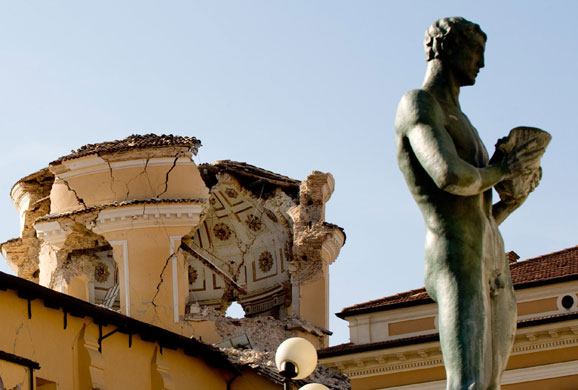
© Vincenzo Pinto/AFP/Getty Images Dome of the damaged cathedral in Piazza Duomo in L'Aquila
A powerful aftershock tonight brought two apartment blocks crashing down in the stricken city of L'Aquila, causing panic among rescue workers and survivors of Monday's deadly earthquake.
Chunks of masonry fell from other damaged buildings, and
the tremor - measured by the US Geological Survey at magnitude 5.6 - was felt as far away as Rome. Within minutes the city resounded again to the scream of sirens as police and rescue workers rushed to the scene.
Meanwhile rescue workers were preparing to carry out what one called a "surgical operation" on a collapsed building in the centre of L'Aquila in the hope of saving the lives of four missing students.
Sergio Basti, the Rome fire brigade engineer leading the attempt, said his team aimed to demolish the residence where the students were trapped "bit by bit from the top, like scraping toppings from a pizza". The students' residence has been one of the main focuses of the rescue operation since early on Monday, shortly after the earthquake that devastated the city and several of the surrounding towns and villages.
The operation was decided on after rescue workers fixed the location of the four students inside the shattered building. But Basti warned: "We do not know whether they are dead or alive."
He said relatives of the four young people who were sleeping in the residence when the earthquake struck had been briefed on what was going to happen. The relatives had spent much of the day waiting anxiously, and sometimes tearfully, outside the building among reporters, police and firefighters. Two of the missing were brought out alive from the residence early on Tuesday morning. This morning, a third student was found dead.
It was the prelude to a day in which the death toll in and around L'Aquila edged up by almost 30 and the balance shifted perceptibly away from the hope of finding more survivors and towards a more exigent calculation of the risks facing the rescuers. Silvio Berlusconi, the Italian prime minister, told a press conference in L'Aquila that the search for the living would go on for another 48 hours. But it was clear that in some places the chances of finding survivors alive had already been written off.
Next to the Piazzale Paoli park where a block of flats had collapsed outwards under the force of the shockwaves, an earth mover was vigorously gouging through the rubble in a way that suggested the rescuers no longer feared disturbing survivors.
The "surgical operation" at the students' residence was decided on after the fourth aftershock since midnight threatened to bring it crashing down. A rescue worker was attached to a crane and lifted above the four-storey building to make an inspection. Afterwards, a member of the team said the residence had been further weakened by the aftershocks and was being kept up by just one of its concrete pillars. Even before they struck, huge concrete slabs that had once been floors were hanging menacingly over the rubble below in which the rescuers were searching.
What chances remained of discovering survivors depended on increasingly delicate probing. A few hundred metres from the students' residence, on the other side of a severely cracked bridge, four Spanish rescue workers were taking a break after working through the night.
None of them had slept since the previous morning. They had just emerged from a nearby house after penetrating to the basement. "We are waiting for a special instrument that can pick up vibrations," said Angelina Molina of the Málaga-based voluntary group GEA, as she took a long drag on her cigarette. "It can pick up even the slightest vibration, even that caused by someone scratching his or her nail on a wall," added her colleague Gabriel Leo.
The periodic wail of sirens and occasional clatter of a helicopter notwithstanding, L'Aquila was like a ghost town today.
Berlusconi said: "Other tremors are possible and the message to the population is not to go back home."
By then, however, a few had already dared to do so. Donatella di Sibio, a 33-year-old shop worker, could not bring herself to leave her parrot behind.
"The staircase has partly collapsed. It's dangerous," she agreed as the parrot sat contentedly on its perch in a cage at her feet. Di Sibio had even brought out some parrot food, along with a handful of specially treasured possessions that her mother had stuffed in a plastic bag.
"That was my grandmother," she said, pointing to a sepia photograph sticking out from the bag.
"I've lived there all my life," said Di Sibio, looking at the 18th century building in which she and her parents shared a flat. "We'd just got it done up. We spent a lot of money on restoring it. The work finished last month. And now it's wrecked."
Reader Comments
to our Newsletter